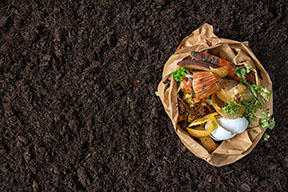Compost
Purchasing information:
- Compost can be used for landscaping, erosion control, turf grass establishment and as a soil amendment and slow release fertilizer.
- The benefits of using compost include water retention, weed suppression, and improved conditions for the overall and long-term health of the soil, as well as the plants, grasses and trees that grow within that soil.
- Recovered materials from which compost is made include food waste, yard waste, manure and biosolids.
- Without good specifications, compost could have adverse effects such as weed seed germination, nitrogen depletion, leaching of pollutants, odor problems, or unaesthetic appearance. -The US Composting Council has developed industry standards and provides guidance on how to select quality compost for other specific applications.
Key specifications:
- Compost shall be derived from biodegradable, organic materials processed in a controlled, biological method of decomposition in compliance with state and federal regulations.
- Compost shall be produced in a permitted composting facility that adheres to their permit requirements.
- Compost containing biosolids shall comply with the United States Environmental Protection Agency (EPA), 40 CFR, Part 503c regulations.
- The compost shall contain no substances harmful to plants and shall be reasonably free (<1% by dry weight) of man-made foreign matter. The compost will possess no objectionable odors and shall not resemble the raw material from which it was derived.
- The attributes of the compost shall fall within the parameters developed by the US Composting Council, Landscape Architecture/Design Specifications for Compost Use. https://cdn.ymaws.com/www.compostingcouncil.org/resource/resmgr/images/newimagesfolder/Landscape-Architecture-Specs.pdf
Other considerations:
- Consider requiring compost to be certified by the US Composting Council Seal of Testing and Approval (STA) program, if enough of your local compost producers can meet this requirement for a competitive bid.
- Consider your preferred particle size or size of screen that the material falls through.
- Suppliers shall provide recommended application rates for end uses.
- More specific NC DOT specifications for the use of compost along NC roads and highways can be found here: https://cdn.ymaws.com/www.compostingcouncil.org/resource/resmgr/images/newimagesfolder/NCDOT.pdf
Resources for additional information:
- US Composting Council - https://www.compostingcouncil.org/page/SpecifyCompost, https://www.compostingcouncil.org/page/BuyCompost
- NC Composting Council - https://carolinacompost.com/
- EPA Biosolids Webpage - https://www.epa.gov/biosolids
- Guidelines for Writing Compost or Mulch Procurement Specifications, California Integrated Waste Management Board - https://1pdf.net/compost-specifications-calrecycle-cagov_591aa129f6065dc36ffe5968
Hydraulic Mulch
Purchasing information:
- Hydraulic mulch is often made from recovered paper and wood. It can be used for erosion control, slope revegetation, sports turf establishment/conditioning, post fire reclamation and mine reclamation. Through hydroseeding, a mixture of water, seeds and hydraulic mulch is sprayed over bare soil to promote the growth of vegetation.
- The inclusion of seed, fertilizer and soil stabilizing products in hydroseeding should be tailored to the specific application.
- Without good specifications, hydro seeding mixes could have adverse effects such as weed seed germination, nitrogen depletion, leaching of pollutants, odor problems, or unaesthetic appearance.
Key specifications:
- Hydraulic mulch shall be composed entirely (100%) of recycled cellulose and/or wood fiber products.
- Proportions of the hydroseeding mixture shall be homogenous and capable of being sprayed to form a porous mat.